2019中考英语作文必备:初中英语 50 个必考句型 + 8 大时态结构
初中英语必考-八大时态结构及用法详解
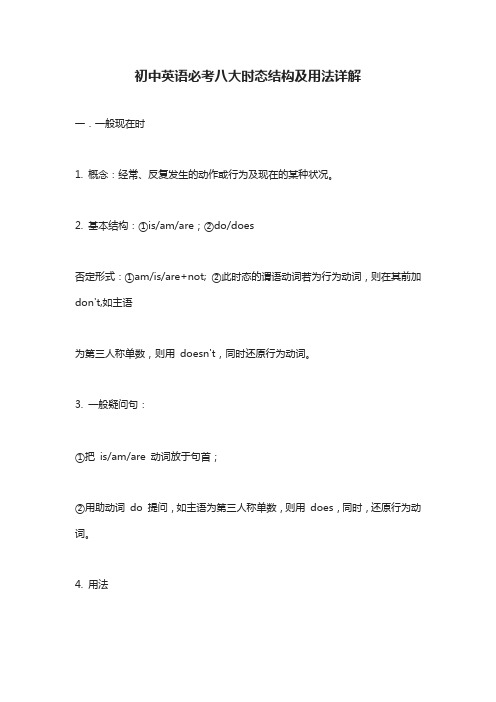
初中英语必考八大时态结构及用法详解一.一般现在时1. 概念:经常、反复发生的动作或行为及现在的某种状况。
2. 基本结构:①is/am/are;②do/does否定形式:①am/is/are+not; ②此时态的谓语动词若为行为动词,则在其前加don't,如主语为第三人称单数,则用doesn't,同时还原行为动词。
3. 一般疑问句:①把is/am/are 动词放于句首;②用助动词do 提问,如主语为第三人称单数,则用does,同时,还原行为动词。
4. 用法1)经常性或习惯性的动作,常与表示频度的时间状语连用。
例如:I leave home for school at 7 every morning. 每天早上我七点离开家。
2)客观真理,客观存在,科学事实。
例如:The earth moves around the sun. 地球绕太阳转动。
Shanghai lies in the east ofChina. 上海位于中国东部。
3)表示格言或警句。
例如:Pride goes before a fall 骄者必败。
注意:此用法如果出现在宾语从句中,即使主句是过去时,从句谓语也要用一般现在时。
例如:Columbus proved that the earth is round. 哥伦布证实了地球是圆的。
4)现在时刻的状态、能力、性格、个性。
例如:I don't want so much. 我不要那么多。
Ann writes good English but does not speak well.安英语写得不错,讲的可不行。
5)一般现在时表示将来含义。
a. 下列动词come, go, arrive, leave, start, begin, return 的一般现在时可以表示将来,主要用来表示在时间上已确定或安排好的事情。
例如:The train leaves at six tomorrow morning. 火车明天上午六点开。
初中英语中考必考的八种时态知识汇总(附常用动名词结构)
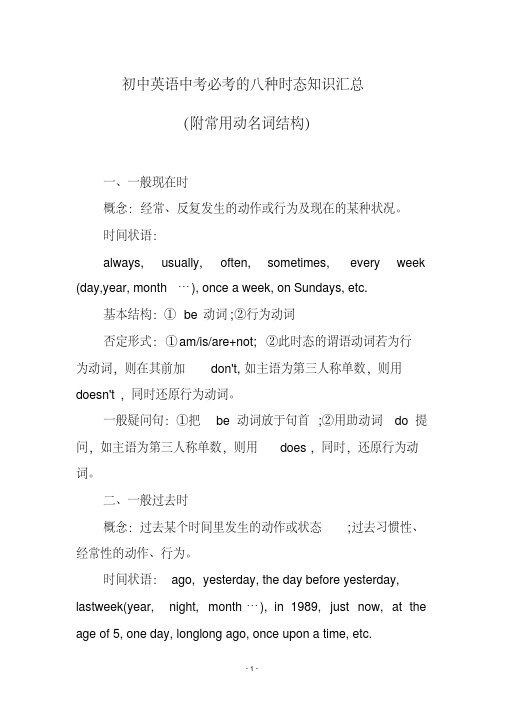
初中英语中考必考的八种时态知识汇总(附常用动名词结构)一、一般现在时概念:经常、反复发生的动作或行为及现在的某种状况。
时间状语:always, usually, often, sometimes, every week (day,year, month…), once a week, on Sundays, etc.基本结构:①be动词;②行为动词否定形式:①am/is/are+not;②此时态的谓语动词若为行为动词,则在其前加don't,如主语为第三人称单数,则用doesn't,同时还原行为动词。
一般疑问句:①把be动词放于句首;②用助动词do提问,如主语为第三人称单数,则用does,同时,还原行为动词。
二、一般过去时概念:过去某个时间里发生的动作或状态;过去习惯性、经常性的动作、行为。
时间状语:ago, yesterday, the day before yesterday, lastweek(year, night, month…), in 1989, just now, at the age of 5, one day, longlong ago, once upon a time, etc.基本结构:①be动词;②行为动词否定形式:①was/were+not;②在行为动词前加didn't,同时还原行为动词。
一般疑问句:①was或were放于句首;②用助动词do 的过去式did 提问,同时还原行为动词。
三、现在进行时概念:表示现阶段或说话时正在进行的动作及行为。
时间状语:now, at this time, these days, etc.基本结构:am/is/are+doing否定形式:am/is/are+not+doing.一般疑问句:把be动词放于句首。
四、过去进行时概念:表示过去某段时间或某一时刻正在发生或进行的行为或动作。
时间状语:at this time yesterday, at that time或以when 引导的谓语动词是一般过去时的时间状语等。
初中英语时态汇总(共8个,中考生提分必背)(直接打印每生一份熟记)
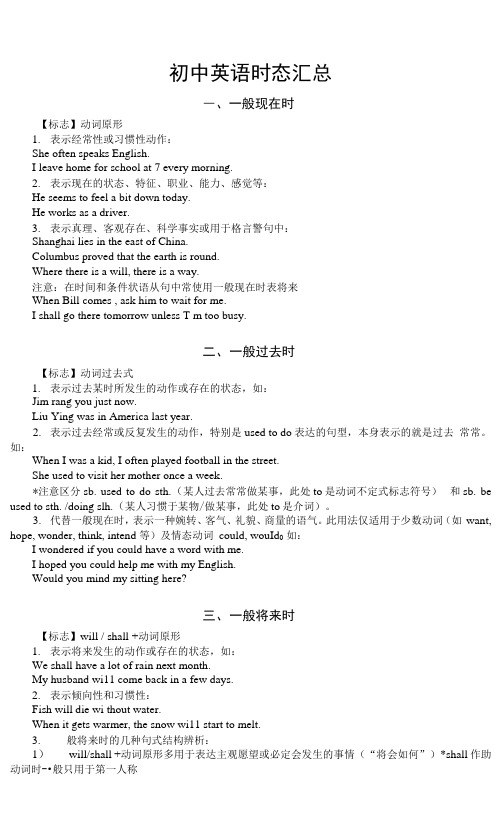
初中英语时态汇总―、一般现在时【标志】动词原形1.表示经常性或习惯性动作:She often speaks English.I leave home for school at 7 every morning.2.表示现在的状态、特征、职业、能力、感觉等:He seems to feel a bit down today.He works as a driver.3.表示真理、客观存在、科学事实或用于格言警句中:Shanghai lies in the east of China.Columbus proved that the earth is round.Where there is a will, there is a way.注意:在时间和条件状语从句中常使用一般现在时表将来When Bill comes , ask him to wait for me.I shall go there tomorrow unless T m too busy.二、一般过去时【标志】动词过去式1.表示过去某时所发生的动作或存在的状态,如:Jim rang you just now.Liu Ying was in America last year.2.表示过去经常或反复发生的动作,特别是used to do表达的句型,本身表示的就是过去常常。
如:When I was a kid, I often played football in the street.She used to visit her mother once a week.*注意区分sb. used to do sth.(某人过去常常做某事,此处to是动词不定式标志符号)和sb. be used to sth. /doing slh.(某人习惯于某物/做某事,此处to是介词)。
3.代替一般现在时,表示一种婉转、客气、礼貌、商量的语气。
此用法仅适用于少数动词(如want, hope, wonder, think, intend 等)及情态动词could, wouId0如:I wondered if you could have a word with me.I hoped you could help me with my English.Would you mind my sitting here?三、一般将来时【标志】will / shall +动词原形1.表示将来发生的动作或存在的状态,如:We shall have a lot of rain next month.My husband wi11 come back in a few days.2.表示倾向性和习惯性:Fish will die wi thout water.When it gets warmer, the snow wi11 start to melt.3.般将来时的几种句式结构辨析:1)will/shall +动词原形多用于表达主观愿望或必定会发生的事情(“将会如何”)*shall 作助动词时-•般只用于第一人称2)be going to +动词原形表示即将发生或打算要做的事:It is going to rain.We are going to have a meeting today.3)be to +动词原形表示按方案或安排即将要发生的动作:He is to visit Japan next year.We are to discuss the report on Monday.4)be about to +动词原形表示即将发生的动作,意为“马上要做某事”,后而一般不跟时间状语,如:The plane is about to start.Don" t worry. I am about to make a close examination on you.四、现在进行时【标志】be +动词的现在分词1.表示说活时正在进行的动作:She is writing a letter upstairs.Who are you waiting for?It is raining hard.2.表示现阶段一直在进行的动作(说话时动作未必正在进行):I hear Mr. Green is writing another novel.3.表示反复出现或习惯性的动作,往往包含说话者赞扬、贲备、厌恶等情绪,通常与always, constantly, continual ly, forever 等频度副词连用。
2019中考英语必考八大时态总结

2019中考英语必考八大时态总结在初中阶段,我们学习到的常用的时态有8种:一般现在时,一般过去时,现在进行时,过去进行时,现在完成时,过去完成时,一般将来时和过去将来时。
一下将对初中阶段英语时态知识要点、考点进行归纳总结,希望能对大家复习备考与解题有所帮助。
.1 一般现在时的用法1) 经常性或习惯性的动作,常与表示频度的时间状语连用。
时间状语:every…,sometimes,ofen,always,usually, twice a week, at…, on SundayI leave home for school at 7 every morning. He watches Tv once a week .2) 客观真理,客观存在,科学事实。
The earth moves around the sun. Shanghai lies in the east of China.3) 表示格言或警句中。
Pride goes before a fall. 骄者必败。
注意:此用法如果出现在宾语从句中,即使主句是过去时,从句谓语也要用一般现在时。
例:Columbus proved that the earth is round..4) 现在时刻的状态、能力、性格、个性。
I don't want so much. Ann Wang writes good English but does not speak well.比较:Now I put the sugar in the cup. I am doing my homework now.第一句用一般现在时,用于操作演示或指导说明的示范性动作,表示言行的瞬间动作。
再如:Now watch me, I switch on the current and stand back. 第二句中的now是进行时的标志,表示正在进行的动作的客观状况,所以后句用一般现在时。
2019年中考生收藏中考必考的八种英语时态
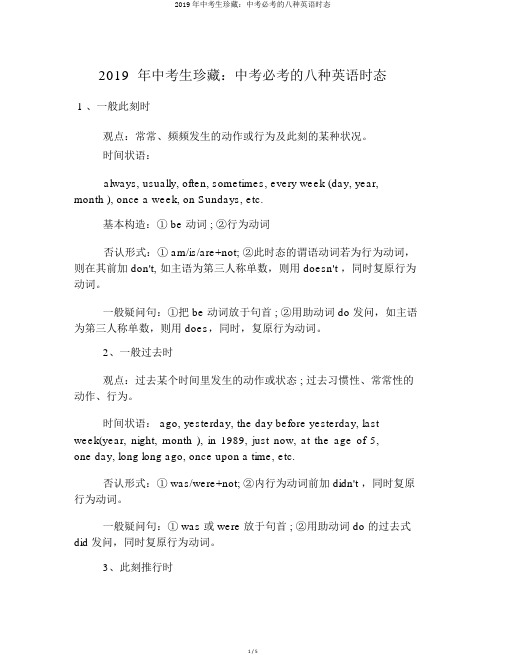
2019 年中考生珍藏:中考必考的八种英语时态1、一般此刻时观点:常常、频频发生的动作或行为及此刻的某种状况。
时间状语:always, usually, often, sometimes, every week (day, year, month ), once a week, on Sundays, etc.基本构造:① be 动词 ; ②行为动词否认形式:① am/is/are+not; ②此时态的谓语动词若为行为动词,则在其前加 don't, 如主语为第三人称单数,则用 doesn't ,同时复原行为动词。
一般疑问句:①把 be 动词放于句首 ; ②用助动词 do 发问,如主语为第三人称单数,则用 does,同时,复原行为动词。
2、一般过去时观点:过去某个时间里发生的动作或状态 ; 过去习惯性、常常性的动作、行为。
时间状语: ago, yesterday, the day before yesterday, lastweek(year, night, month ), in 1989, just now, at the age of 5,one day, long long ago, once upon a time, etc.否认形式:① was/were+not; ②内行为动词前加 didn't ,同时复原行为动词。
一般疑问句:① was 或 were 放于句首 ; ②用助动词 do 的过去式did 发问,同时复原行为动词。
3、此刻推行时观点:表示现阶段或说话时正在推行的动作及行为。
时间状语: now, at this time, these days, etc.基本构造: am/is/are+doing否认形式: am/is/are+not+doing.一般疑问句:把be 动词放于句首。
4、过去推行时观点:表示过去某段时间或某一时辰正在发生或推行的行为或动作。
初中英语8大时态总结
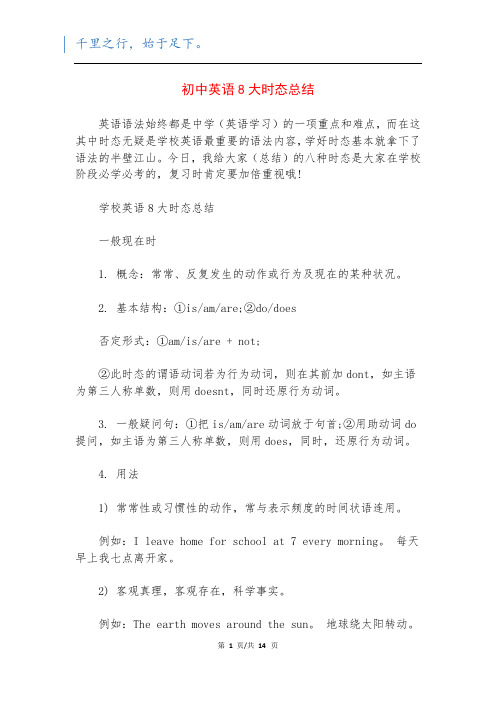
初中英语8大时态总结英语语法始终都是中学(英语学习)的一项重点和难点,而在这其中时态无疑是学校英语最重要的语法内容,学好时态基本就拿下了语法的半壁江山。
今日,我给大家(总结)的八种时态是大家在学校阶段必学必考的,复习时肯定要加倍重视哦!学校英语8大时态总结一般现在时1. 概念:常常、反复发生的动作或行为及现在的某种状况。
2. 基本结构:①is/am/are;②do/does否定形式:①am/is/are + not;②此时态的谓语动词若为行为动词,则在其前加dont,如主语为第三人称单数,则用doesnt,同时还原行为动词。
3. 一般疑问句:①把is/am/are动词放于句首;②用助动词do 提问,如主语为第三人称单数,则用does,同时,还原行为动词。
4. 用法1) 常常性或习惯性的动作,常与表示频度的时间状语连用。
例如:I leave home for school at 7 every morning。
每天早上我七点离开家。
2) 客观真理,客观存在,科学事实。
例如:The earth moves around the sun。
地球绕太阳转动。
Shanghai lies in the east of China。
上海位于中国东部。
3) 表示格言或警句。
例如:Pride goes before a fall。
骄者必败。
留意:此用法假如消失在宾语从句中,即使主句是过去时,从句谓语也要用一般现在时。
例如:Columbus proved that the earth is round。
哥伦布证明了地球是圆的。
4) 现在时刻的状态、力量、性格、共性。
例如:I dont want so much。
我不要那么多。
Ann writes good English but does not speak well。
安英语写得不错,讲的可不行。
5) 一般现在时表示将来含义a.下列动词come, go, arrive, leave, start, begin, return 的一般现在时可以表示将来,主要用来表示在时间上已确定或支配好的事情。
2019中考英语作文必备:初中英语 50 个必考句型 + 8 大时态结构
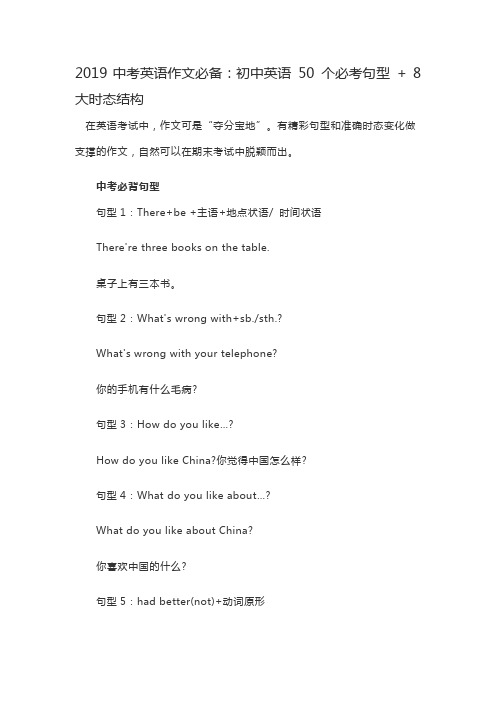
2019中考英语作文必备:初中英语50 个必考句型+ 8 大时态结构在英语考试中,作文可是“夺分宝地”。
有精彩句型和准确时态变化做支撑的作文,自然可以在期末考试中脱颖而出。
中考必背句型句型1:There+be +主语+地点状语/ 时间状语There're three books on the table.桌子上有三本书。
句型2:What's wrong with+sb./sth.?What's wrong with your telephone?你的手机有什么毛病?句型3:How do you like…?How do you like China?你觉得中国怎么样?句型4:What do you like about…?What do you like about China?你喜欢中国的什么?句型5:had better(not)+动词原形You'd better ask that policeman over there.你最好去问问那边的那个警察。
句型7:Thank+sb.+for (doing) sth.Thank you for coming to see me.感谢你来看我。
句型8:So+be/情态动词/助动词+主语He is a student. So am I.他是一个学生,我也是。
句型9:not…until…He didn't have supper until his parents came back. 直到他的父母回来他才吃饭。
句型10:比较级十and+比较级The baby cried harder and harder.那孩子哭得越来越厉害。
句型11:the+比较级,the+比较级The more one has,the more one wants.拥有的越多,想要的越多。
句型12:…as+adj./adv.+as……not as(so)+adj./adv.+as…Last Sunday the weather was not so wet as it is today.上个星期天的天气不如今天的天气潮湿。
初中英语必考八大时态结构及用法详解
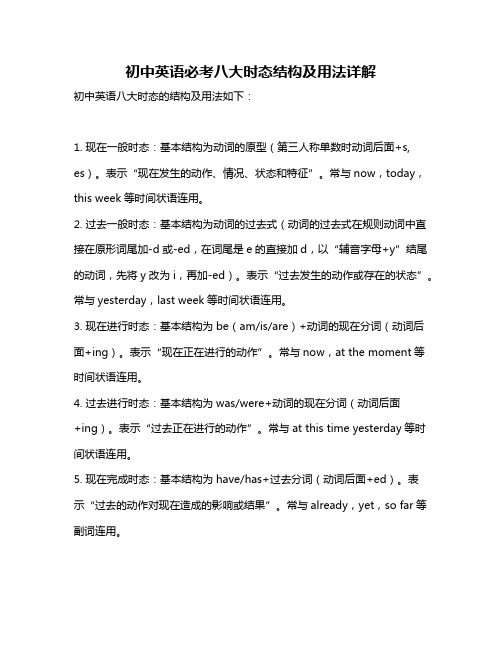
初中英语必考八大时态结构及用法详解初中英语八大时态的结构及用法如下:1. 现在一般时态:基本结构为动词的原型(第三人称单数时动词后面+s, es)。
表示“现在发生的动作、情况、状态和特征”。
常与now,today,this week等时间状语连用。
2. 过去一般时态:基本结构为动词的过去式(动词的过去式在规则动词中直接在原形词尾加-d或-ed,在词尾是e的直接加d,以“辅音字母+y”结尾的动词,先将y改为i,再加-ed)。
表示“过去发生的动作或存在的状态”。
常与yesterday,last week等时间状语连用。
3. 现在进行时态:基本结构为be(am/is/are)+动词的现在分词(动词后面+ing)。
表示“现在正在进行的动作”。
常与now,at the moment等时间状语连用。
4. 过去进行时态:基本结构为was/were+动词的现在分词(动词后面+ing)。
表示“过去正在进行的动作”。
常与at this time yesterday等时间状语连用。
5. 现在完成时态:基本结构为have/has+过去分词(动词后面+ed)。
表示“过去的动作对现在造成的影响或结果”。
常与already,yet,so far等副词连用。
6. 过去完成时态:基本结构为had+过去分词(动词后面+ed)。
表示“过去的动作在过去的某个时间之前已经完成或发生的动作或存在的状态”。
常与by the end of last year,by the time of等时间状语连用。
7. 现在完成进行时态:基本结构为have/has been+动词的现在分词(动词后面+ing)。
表示“动作从过去某时开始,一直延续到现在,或者刚刚完成”。
常与for several days,since等时间状语连用。
8. 过去完成进行时态:基本结构为had been+动词的现在分词(动词后面+ing)。
表示“过去的某个动作从过去某时开始,一直延续到过去的某个时间,或者刚刚完成”。
2019中考倒计时100天,中考英语必考八大时态总结------
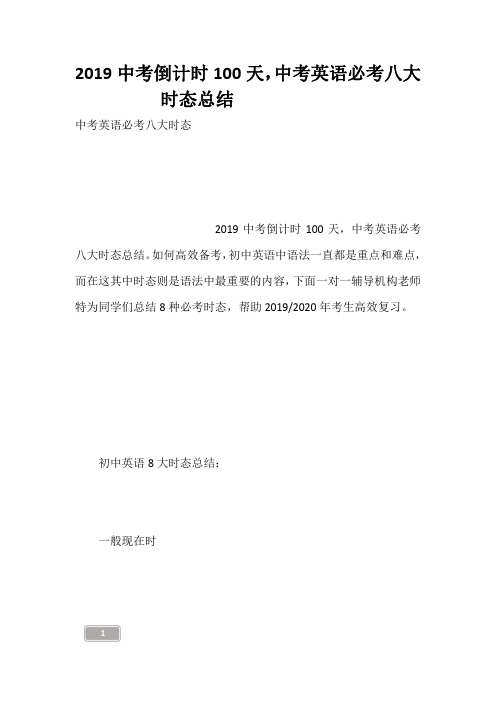
2019中考倒计时100天,中考英语必考八大时态总结中考英语必考八大时态2019中考倒计时100天,中考英语必考八大时态总结。
如何高效备考,初中英语中语法一直都是重点和难点,而在这其中时态则是语法中最重要的内容,下面一对一辅导机构老师特为同学们总结8种必考时态,帮助2019/2020年考生高效复习。
初中英语8大时态总结:一般现在时1. 概念:经常、反复发生的动作或行为及现在的某种状况。
2. 基本结构:①is/am/are;②do/does否定形式:①am/is/are + not;②此时态的谓语动词若为行为动词,则在其前加dont,如主语为第三人称单数,则用doesnt,同时还原行为动词。
3. 一般疑问句:①把is/am/are动词放于句首;②用助动词do 提问,如主语为第三人称单数,则用does,同时,还原行为动词。
4. 用法1) 经常性或习惯性的动作,常与表示频度的时间状语连用。
例如:I leave home for school at 7 every morning。
每天早上我七点离开家。
2) 客观真理,客观存在,科学事实。
例如:The earth moves around the sun。
地球绕太阳转动。
Shanghai lies in the east of China。
上海位于中国东部。
3) 表示格言或警句。
例如:Pride goes before a fall。
骄者必败。
注意:此用法如果出现在宾语从句中,即使主句是过去时,从句谓语也要用一般现在时。
例如:Columbus proved that the earth is round。
哥伦布证实了地球是圆的。
4) 现在时刻的状态、能力、性格、个性。
例如:I dont want so much。
我不要那么多。
Ann writes good English but does not speak well。
安英语写得不错,讲的可不行。
5) 一般现在时表示将来含义a.下列动词come,go,arrive,leave,start,begin,return 的一般现在时可以表示将来,主要用来表示在时间上已确定或安排好的事情。
(完整word)初中英语语法八大时态总结范文文档
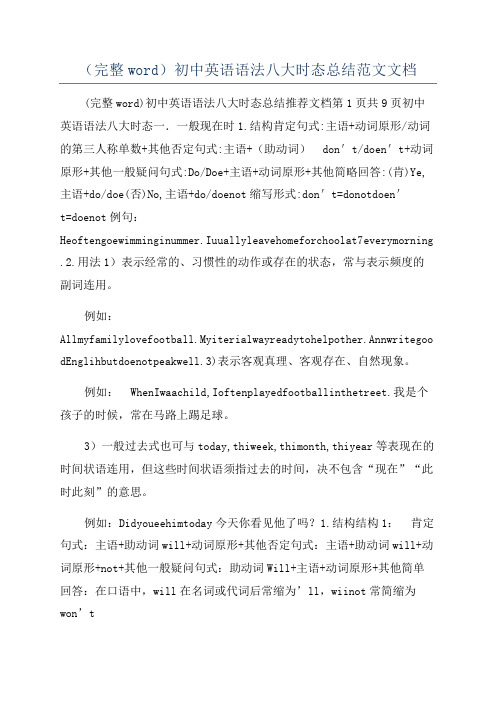
(完整word)初中英语语法八大时态总结范文文档(完整word)初中英语语法八大时态总结推荐文档第1页共9页初中英语语法八大时态一.一般现在时1.结构肯定句式:主语+动词原形/动词的第三人称单数+其他否定句式:主语+(助动词)don't/doen't+动词原形+其他一般疑问句式:Do/Doe+主语+动词原形+其他简略回答:(肯)Ye,主语+do/doe(否)No,主语+do/doenot缩写形式:don't=donotdoen't=doenot例句:Heoftengoewimminginummer.Iuuallyleavehomeforchoolat7everymorning .2.用法1)表示经常的、习惯性的动作或存在的状态,常与表示频度的副词连用。
例如:Allmyfamilylovefootball.Myiterialwayreadytohelpother.Annwritegoo dEnglihbutdoenotpeakwell.3)表示客观真理、客观存在、自然现象。
例如:WhenIwaachild,Ioftenplayedfootballinthetreet.我是个孩子的时候,常在马路上踢足球。
3)一般过去式也可与today,thiweek,thimonth,thiyear等表现在的时间状语连用,但这些时间状语须指过去的时间,决不包含“现在”“此时此刻”的意思。
例如:Didyoueehimtoday今天你看见他了吗?1.结构结构1:肯定句式:主语+助动词will+动词原形+其他否定句式:主语+助动词will+动词原形+not+其他一般疑问句式:助动词Will+主语+动词原形+其他简单回答:在口语中,will在名词或代词后常缩为’ll,wiinot常简缩为won’t在疑问句中,主语为第一人称时(I和we)时,常用助动词hall例如:She’llgotoplaybaketball.Shallwegotothezoo结构2:肯定句式:主语+begoingto+动词原形+其他否定句式:主语+benotgoingto+动词原形+其他一般疑问句式:Be+主语+goingto+动词原形+其他简略回答:(肯)Ye,主语+be(否)No,主语+benot2.用法1)表示将来某个时间要发生的动作或存在的状态,常与tomorrow,ne某tday(week,month,year…),oon,inafewminute,by…,thedayaftertomorrow等连用。
英语的8大时态构成及造句
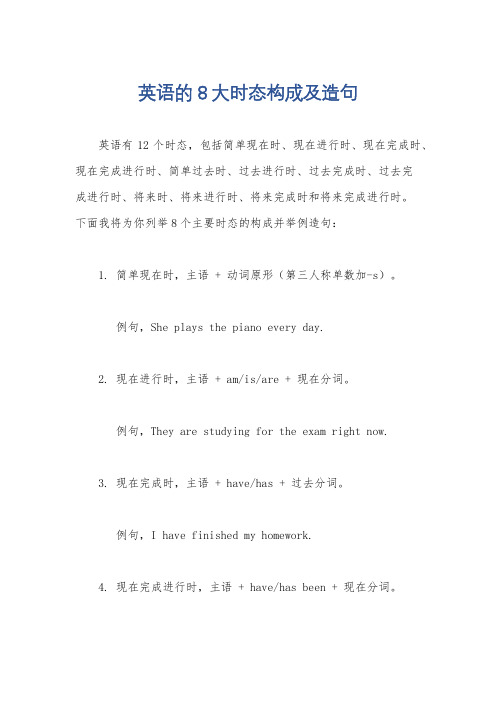
英语的8大时态构成及造句英语有12个时态,包括简单现在时、现在进行时、现在完成时、现在完成进行时、简单过去时、过去进行时、过去完成时、过去完成进行时、将来时、将来进行时、将来完成时和将来完成进行时。
下面我将为你列举8个主要时态的构成并举例造句:1. 简单现在时,主语 + 动词原形(第三人称单数加-s)。
例句,She plays the piano every day.2. 现在进行时,主语 + am/is/are + 现在分词。
例句,They are studying for the exam right now.3. 现在完成时,主语 + have/has + 过去分词。
例句,I have finished my homework.4. 现在完成进行时,主语 + have/has been + 现在分词。
例句,He has been working here for five years.5. 简单过去时,主语 + 动词过去式。
例句,We watched a movie last night.6. 过去进行时,主语 + was/were + 现在分词。
例句,She was reading a book when I called her.7. 过去完成时,主语 + had + 过去分词。
例句,They had already left when I arrived.8. 过去完成进行时,主语 + had been + 现在分词。
例句,By the time I got there, they had been waiting for over an hour.希望以上例句能够帮助你更好地理解这些时态的构成和用法。
初中英语必考八大时态结构及用法详解
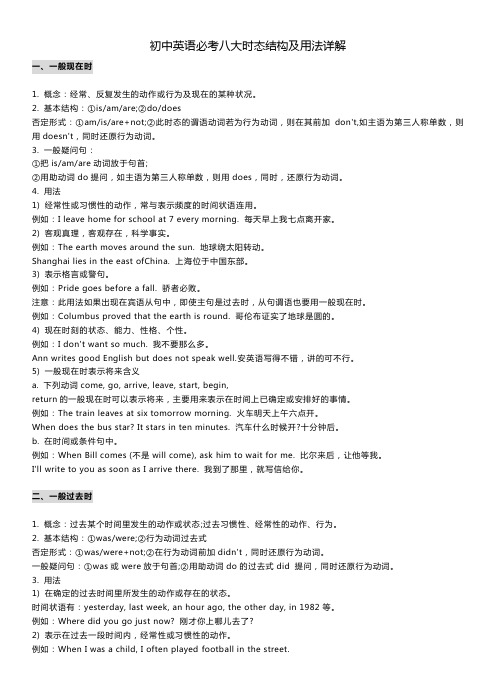
初中英语必考八大时态结构及用法详解一、一般现在时1. 概念:经常、反复发生的动作或行为及现在的某种状况。
2. 基本结构:①is/am/are;②do/does否定形式:①am/is/are+not;②此时态的谓语动词若为行为动词,则在其前加don't,如主语为第三人称单数,则用doesn't,同时还原行为动词。
3. 一般疑问句:①把is/am/are动词放于句首;②用助动词do提问,如主语为第三人称单数,则用does,同时,还原行为动词。
4. 用法1) 经常性或习惯性的动作,常与表示频度的时间状语连用。
例如:I leave home for school at 7 every morning. 每天早上我七点离开家。
2) 客观真理,客观存在,科学事实。
例如:The earth moves around the sun. 地球绕太阳转动。
Shanghai lies in the east ofChina. 上海位于中国东部。
3) 表示格言或警句。
例如:Pride goes before a fall. 骄者必败。
注意:此用法如果出现在宾语从句中,即使主句是过去时,从句谓语也要用一般现在时。
例如:Columbus proved that the earth is round. 哥伦布证实了地球是圆的。
4) 现在时刻的状态、能力、性格、个性。
例如:I don't want so much. 我不要那么多。
Ann writes good English but does not speak well.安英语写得不错,讲的可不行。
5) 一般现在时表示将来含义a. 下列动词come, go, arrive, leave, start, begin,return的一般现在时可以表示将来,主要用来表示在时间上已确定或安排好的事情。
例如:The train leaves at six tomorrow morning. 火车明天上午六点开。
初中英语中考必考时态结构及用法详解(共八种)
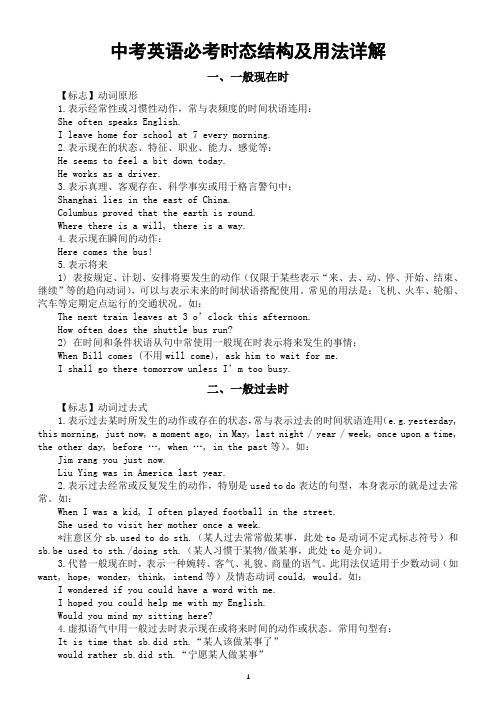
中考英语必考时态结构及用法详解一、一般现在时【标志】动词原形1.表示经常性或习惯性动作,常与表频度的时间状语连用:She often speaks English.I leave home for school at 7 every morning.2.表示现在的状态、特征、职业、能力、感觉等:He seems to feel a bit down today.He works as a driver.3.表示真理、客观存在、科学事实或用于格言警句中:Shanghai lies in the east of China.Columbus proved that the earth is round.Where there is a will, there is a way.4.表示现在瞬间的动作:Here comes the bus!5.表示将来1) 表按规定、计划、安排将要发生的动作(仅限于某些表示“来、去、动、停、开始、结束、继续”等的趋向动词),可以与表示未来的时间状语搭配使用。
常见的用法是:飞机、火车、轮船、汽车等定期定点运行的交通状况。
如:The next trai n leaves at 3 o’clock this afternoon.How often does the shuttle bus run?2) 在时间和条件状语从句中常使用一般现在时表示将来发生的事情:When Bill comes (不用will come), ask him to wait for me.I shall go there tomorrow unless I’m too busy.二、一般过去时【标志】动词过去式1.表示过去某时所发生的动作或存在的状态,常与表示过去的时间状语连用(e.g.yesterday, this morning, just now, a moment ago, in May, last night / year / week, once upon a time, the other day, before …, when …, in the past等)。
2019年中考英语八大时态语法讲解

2019年中考英语八大时态语法讲解2019年中考英语八大时态语法讲解(绝对精品文档,价值很高,值得下载打印背诵) 一般现在时概念:1. 表示现在的状态eg:I am twelve.2. 表示经常或习惯性动作eg:he gets up at six.3. 表示主语所具备的性格或能力eg:he likes English.4. 表示客观事实真理eg:the earth goes around the sun.标志性词语:Often,usually,sometimes,always,never,on Sunday,every year/month/dayEg: she often goes to school on foot.He goes to park once a week.行为动词第三人称单数加-s 的形式1. 一般动词直接加-s2. 以辅音字母+y,把 y 改 i 再加 es,3. 以 s,x,sh,ch 结尾的动词加-es4. 以 o 结尾的动词一般加-es5. 特殊情况:have—has基本结构:Be 型:肯定式:主语+be 动词(am/is/are)+其他表状态(there be+n)否定式:主语+be 动词(am/is/are)+not+其他疑问式:将 be 动词提前放句首,第三人称动词变原形(一二人称互换,第三人称不变)特殊式:特殊疑问词+be+主语实义动词型:肯定式:主语+行为动词(注意人称三单形式)+其他否定式:主语+do n’t/doesn’t+行为动词+其他疑问式:一般式:Do/Does+主语+行为动词原形+其他特殊式:特殊疑问词+do/does+主语+谓语小试牛刀:写出下列动词的第三人称形式wash:match:study:finish:go:snow:carry:stop:see:drive:let:teach:keep:join:put:do:drink:toy:play: begin:take:run:fly:talk:stay:look:watch:think:carry:fix:单项选择1. There an English film at the cinema now.A:is B:are C:am D:be2. The picture nice.A:look B:looks C:looked D:be look3. He sits down and soon asleep.A:fall B:falling C:falled D: falls4. The water sweet.A:drinking B:drinks C:drink D:to drink5. I up at six but Mike up at sevenA:get,gets B:get ,get C:gets,get D:getting, to get6. My father for eight hours every day.A:working B:works C:work D:to work7. Uncle Wang never English, because he know how to say it.A:speak,doesn’t B:speak,don’t C:speaks,don’t D:speaks,doesn’t8. On Sunday my daughter watching TV and my son to play footballwith his friends.A:like,want B:likes,want C:like,wants D:likes,wants 9. Su Yangusually some clothes on Sunday.A:washed B:washs C:washes D:washing 10. Su Hai and Su Yang eight lessons this termA:have B:has C:haves D:having用所给词的正确形式填空A. We often (not play)on the playground.B.you (brush) your teeth every day.C. How many lessons your classmate (have) on Sunday.D. It (take) me two hours to finish my homework every day.E. The child often (watch) TV in the evening.F. What (do) he usually (do) after school.G. John (study) Math , Chinese ,English ,Science and Art at school.H. Mr. Wang often (go) to Shanghai.I. There (be) a football match on TV every morning.J. We (not watch)TV on Monday.句式训练Do you like to play football after school?肯定句肯定/否定回答:I have many books.否定句:一般疑问句:肯定回答:否定回答:Nancy doesn’t run fast.肯定句:I usually play football on Friday afternoon.一般疑问句:特殊疑问句:肯定/否定回答:Tom does his homework at home. 否定句:一般疑问句:特殊疑问句:Mike has two letters for him.一般疑问句:特殊疑问句:否定回答:判断正误1. Is your brother speak English?2. Does he likes going fishing?3. Jane do his homework every morning.4. He like play basketball with his friends.5. We eats dinner at six and go to bed at eleven.6. My dog runs fast.7. He speak English very well.8. What do they usually do on Saturday.9. My mother don’t have breakfast this morning.10. I like reading books on the library every day.中考真题1.Jenny! Do you know that one-third of the boys in our class the singer Zhang Shao Han?A. likeB. likesC.liking2. The sense of happiness will increase if you what you like to do.A. doB. didC. will do3. Betty will ring me up when she inBeijing.A. arriveB. arrivesC. arrivedD. willarrive4. If you your homework, you can go out to play football.5.Now my father his bike to work every day instead of driving.A. rideB. r od eC. ridesD. will ride6. This girl is rea d y t o help p eo pl e an y time. Wh e n sh e is on t h e bu s,sh e al w a y s her seat to someone in need.A. givesB. giveC. gaveD.giving概念:一般过去时表示过去某个时间収生的动作或存在的状态. Eg: I got up at seven yesterday表示过去经常収生的动作或存在的状态. Eg: he always went to school by car last term标志性词语:yesterday,last month/year/week/night,the day beforeyesterday,in the past,at that time,two days ago,just n ow……..动词过去时的变化规则:一般在词尾直接+ed play——played以 e 结尾的动词直接+d taste—— tasted末尾三个字母以“辅+元+辅”且为重读闭音节,双写末尾辅音+ed stop——stopped以辅音字母+y,改 y 为 i 再+ed study——studied不规则动词过去式:am/is: a re:do:see:sa y:give: eat:w rit e: sp en d:get:take:sp eak:drin k:g o:r un:rid e:sle ep:c o me:sin g:swim:s t and:has/ha ve:pu t:sit:rea d:结构:Be 型肯定式:主语+be 动词(was/were)+其他否定式:主语+wasn’t/weren’t+其他疑问式:Be 动词+主语+其他(一二人称互换,第三人称不变)特殊疑问句:特殊疑问词+was/were+主语+其他实义动词型肯定式:主语+动词过去式+其他否定式:主语+didn’t+动词原形+其他疑问式:Did+主语+动词原形+其他特殊疑问句:特殊疑问词+did+主语+动词原形+其他用所给单词正确形式填空◆We (enjoy) ourselves at the party last night.◆Jack (study) for the English test last Sunday.◆ you (go) to the Great Wall last year?◆What day (be) it yesterday?◆The old man (be)ill and went to see a doctor.◆We (have) a party last night.◆We (visit) the museum and went home.◆—How (be) the students? —They were very friendly.◆My mother (not do) housework yesterday. ◆—he (have) lunch at nine? —No, he did n’t.◆They (buy) a guitar yesterday.◆the cat (eat)a bird yesterday night.◆They (play)chess in the classroom last PE lesson.◆Nancy (pick)up orange on the farm last week.◆My mother (cook)a nice food last spring festival.◆I (be)at school just now.◆He (be)at the camp last week.◆The mobile phone (be)on the table yesterday evening.◆I (make)a model ship with Mike yesterday.◆What (do)you do last month.单项选择( ) 1. Lee his mobile phone at home.A. leaveB. leavesC. leavedD. left( ) 2. he a good rest? No, he didn’t.A. Do, hadB. Did, haveC. Did, hadD. Was, had( ) 3. As soon as he , he to his family.A. arrived, writesB. arrived, writtenC. arrived, wroteD. arriveds, write( ) 4. Mr. Black was late because he his way.A. lostedB. loseC. losesD. lost( ) 5. When Lee school this morning?A. did, got toB. did, get toC. did, getD. did, got( ) 6. Will you please say it again? I quite you.A. didn’t, hearB. don’t, heardC. didn’t, heardD. don’t, hear ( ) 7. you at six o’c lock yesterday?A. Do ,get upB. Did, get upD. Did, got up ( ) 8.What did you see ?A. nowB. every dayC. these daysD. just now ( ) 9.He went into the room and the door.A. lockB. lockingC. locksD. locked ( ) 10. —What you last week? —I bought a bag.A. did ,buyB. did , boughtC. do, buyD. do, bought ( ) 11. —he his lunch? —Yes, he did.A. Does ,hasB. Does, haveC. Did, haveD. Did, had ( )12.—Did the thieves into the car? —No, they .A. fell, did n’tB. fall(落下), didC. jump(跳), didn’tD. jump, did ( ) 13. -When did May come back from Hong Kong?-She from Hong Kong last Friday.A. come backB. comes backC. returned backD. came back( ) 14. she this dictionary in the bookshop nearby last week?A. Did, buyC. Did, boughtD. Does, buys ( ) 15. He to the station this morning and was for the train.A. hurry, in timeB. hurries, on timeC. hurried, in timeD. hurried, at time句型转换1. Frank read an interesting book about history. (一般疑问句)Frank an interesting book about history?2. Thomas spent RMB 10 on this book. (否定句)Thomas RMB 10 on this book.3. I didn’t have any friends. (一般疑问句)have friends?4. She watched TV after supper(划线部分提问)she after supper.5. There was some orange in the fridge.(一般疑问句)there_ orange in the fridge?改错题1. How is Jane yesterday?2. He go to school by bus last week.3. He often goes home at 6:00 last month.4. I can fly kites seven years ago.5. Did you saw him just now.6. Tom wasn’t watch TV last night.7. I didn’t my homework yesterday. 8. He wait for you three hours ago.9. Who find it just now ? 10. What did he last week?综合训练。
初中英语必考八大时态结构及用法详解

初中英语必考八大时态结构及用法详解一、一般现在时1. 概念:经常、反复发生的动作或行为及现在的某种状况。
2. 基本结构:①is/am/are;②do/does否定形式:①am/is/are+not;②此时态的谓语动词若为行为动词,则在其前加don't,如主语为第三人称单数,则用doesn't,同时还原行为动词。
3. 一般疑问句:①把is/am/are动词放于句首;②用助动词do提问,如主语为第三人称单数,则用does,同时,还原行为动词。
4. 用法1) 经常性或习惯性的动作,常与表示频度的时间状语连用。
例如:I leave home for school at 7 every morning. 每天早上我七点离开家。
2) 客观真理,客观存在,科学事实。
例如:The earth moves around the sun. 地球绕太阳转动。
Shanghai lies in the east ofChina. 上海位于中国东部。
3) 表示格言或警句。
例如:Pride goes before a fall. 骄者必败。
注意:此用法如果出现在宾语从句中,即使主句是过去时,从句谓语也要用一般现在时。
例如:Columbus proved that the earth is round. 哥伦布证实了地球是圆的。
4) 现在时刻的状态、能力、性格、个性。
例如:I don't want so much. 我不要那么多。
Ann writes good English but does not speak well.安英语写得不错,讲的可不行。
5) 一般现在时表示将来含义a. 下列动词come, go, arrive, leave, start, begin,return的一般现在时可以表示将来,主要用来表示在时间上已确定或安排好的事情。
例如:The train leaves at six tomorrow morning. 火车明天上午六点开。
中考英语必考的8种时态
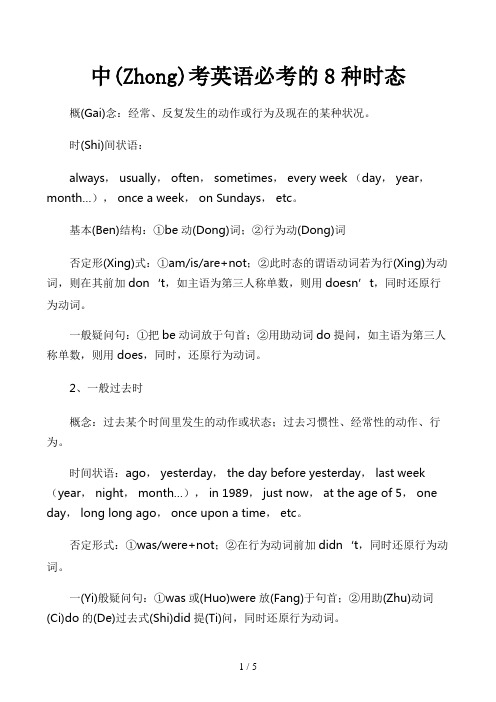
中(Zhong)考英语必考的8种时态概(Gai)念:经常、反复发生的动作或行为及现在的某种状况。
时(Shi)间状语:always, usually, often, sometimes, every week (day, year,month…), once a week, on Sundays, etc。
基本(Ben)结构:①be动(Dong)词;②行为动(Dong)词否定形(Xing)式:①am/is/are+not;②此时态的谓语动词若为行(Xing)为动词,则在其前加don‘t,如主语为第三人称单数,则用doesn’t,同时还原行为动词。
一般疑问句:①把be动词放于句首;②用助动词do提问,如主语为第三人称单数,则用does,同时,还原行为动词。
2、一般过去时概念:过去某个时间里发生的动作或状态;过去习惯性、经常性的动作、行为。
时间状语:ago, yesterday, the day before yesterday, last week (year, night,month…), in 1989, just now, at the age of 5, one day, long long ago, once upon a time, etc。
否定形式:①was/were+not;②在行为动词前加didn‘t,同时还原行为动词。
一(Yi)般疑问句:①was或(Huo)were放(Fang)于句首;②用助(Zhu)动词(Ci)do的(De)过去式(Shi)did提(Ti)问,同时还原行为动词。
3、现在进行时概念:表示现阶段或说话时正在进行的动作及行为。
时间状语:now, at this time, these days, etc。
基本结构:am/is/are+doing否定形式:am/is/are+not+doing。
一般疑问句:把be动词放于句首。
4、过去进行时概念:表示过去某段时间或某一时刻正在发生或进行的行为或动作。
- 1、下载文档前请自行甄别文档内容的完整性,平台不提供额外的编辑、内容补充、找答案等附加服务。
- 2、"仅部分预览"的文档,不可在线预览部分如存在完整性等问题,可反馈申请退款(可完整预览的文档不适用该条件!)。
- 3、如文档侵犯您的权益,请联系客服反馈,我们会尽快为您处理(人工客服工作时间:9:00-18:30)。
2019中考英语作文必备:初中英语50 个必考句型+ 8 大时态结构在英语考试中,作文可是“夺分宝地”。
有精彩句型和准确时态变化做支撑的作文,自然可以在期末考试中脱颖而出。
中考必背句型句型1:There+be +主语+地点状语/ 时间状语There're three books on the table.桌子上有三本书。
句型2:What's wrong with+sb./sth.?What's wrong with your telephone?你的手机有什么毛病?句型3:How do you like…?How do you like China?你觉得中国怎么样?句型4:What do you like about…?What do you like about China?你喜欢中国的什么?句型5:had better(not)+动词原形You'd better ask that policeman over there.你最好去问问那边的那个警察。
句型7:Thank+sb.+for (doing) sth.Thank you for coming to see me.感谢你来看我。
句型8:So+be/情态动词/助动词+主语He is a student. So am I.他是一个学生,我也是。
句型9:not…until…He didn't have supper until his parents came back. 直到他的父母回来他才吃饭。
句型10:比较级十and+比较级The baby cried harder and harder.那孩子哭得越来越厉害。
句型11:the+比较级,the+比较级The more one has,the more one wants.拥有的越多,想要的越多。
句型12:…as+adj./adv.+as……not as(so)+adj./adv.+as…Last Sunday the weather was not so wet as it is today.上个星期天的天气不如今天的天气潮湿。
句型13:more/less +adj.+than…I think art is less important than music.我认为艺术不如音乐重要。
句型14:stop…from doing sth.The Great Green Wall will stop the wind from blowing the earth away.绿色长城将阻挡风吹走土壤。
句型15:both…and…Both you and I are students.我和你都是学生。
句型16:either…or…Either you or he is wrong.不是你错就是他错。
句型17:neither…nor…Neither he nor I am a student.我和他都不是学生。
句型18:…as soon as…As soon as I see him, I'll give him the message.我一见到他就把你的消息告诉他。
句型19:so+adj./adv.+that…I was so tired that I didn't want to speak.我累得连话也不想说了。
句型20:Though…十主句Though I like writing to my pen-friend,it takes a lot of time. 虽然我喜欢给笔友写信,但它要耗费我大量时间。
句型21:be going toThis afternoon I'm going to buy an English book.今天下午我要去买本英语书。
句型22:be different fromI think this is different from Chinese names.我认为这与汉语名字不同。
句型23:Welcome (back) to…Welcome back to school!欢迎回到学校!句型24:have fun doingWe're going to have fun learning English this term.这学期我们将兴味盎然地学习讲英语。
句型25:…because…/…, so..…I don't know all your names because this is our first lesson. 因为这是我们的第一节课,所以我并不知道你们所有人的名字。
句型26:Why don't you…/ Why not…?Why don't you come to school a little earlier?为什么不早点到校呢?句型27:make itLet's make it half past nine.让我们定在九点半吧!句型28:have nothing to doThey have nothing to do every day.他们每天无所事事。
句型29:be sure/be sure of/ about sth. /be sure to do sth.I was not sure of/about the way, so I asked someone.我对于怎么走没有把握,所以我问别人了。
句型30:between…and…There is a shop between the hospital and the school.在那家医院和那所学校之间有一家商店。
句型31:keep sb. /sth. +adj. /V-ing /介词补语/adv.You must keep your classroom clean.你们必须保持教室干净。
Sorry to have kept you waiting.对不起,让你久等。
句型32:find+宾语+宾补He finds it very hard to travel around the big city.他发现要环游这个大城市是很难的。
句型33:…not…any more / longerThe old man doesn't travel any more.这位老人不再旅行了。
句型34:What's the weather like…?What's the weather like in spring in your hometown?在你们家乡,春天天气怎么样?句型35:There is no time to do/have no time to doThere was no time to think.没有时间思考。
I have no time to go home for lunch.我没有时间回家吃午饭。
句型36:Help oneself to…Help yourself to some fish.吃鱼吧!句型37:used to doI used to read this kind of story books.我过去常读这种故事书。
句型38:borrow…fromI borrowed a book from him.我从他那借了一本书。
句型39:lend sb. sth. /lend sth. to sb.He lent me a story book/He lent a story book to me. 他借了本故事书给我。
句型40:have been toHave you ever been to Hawaii?你曾去过夏威夷吗?句型41:have gone toWhere's he? He's gone to Washington.他在哪儿?他去华盛顿了。
句型42:be famous forHawaii is famous for its beautiful beaches.夏威夷以它美丽的海滩而出名。
句型43:No matter+疑问句+主句No matter when you come,you are welcomed.无论你们什么时候来,都受欢迎。
句型44:be afraid (of/to do/that..)Don't be afraid of making mistakes when speaking English.当说英语时不要害怕犯错误。
句型45:…as…as possible/…as…as sb. canI hope to see him as soon as possible.我希望能尽快见到他。
He ran here as fast as he could.他尽最大努力跑到这儿。
句型46:practise /enjoy/finish doingTom enjoys playing football very much.汤姆很喜欢踢足球。
He finished reading the story book.他看完了那本故事书。
句型47:ask sb. (not) to do sth.Her mother ask her to clean the room.她妈妈叫她打扫房间。
句型48:be worth (doing) …This book is worth reading.这本书值得读。
句型49:seem to do / seem +adj. / (介词短语)He seems to be angry.他似乎生气了。
The house seems too noisy.这房子似乎太吵了。
句型50:It's said that…It's said that one of the most dangerous sharks is the Great White Shark.据说大白鲨是最危险的鲨鱼之一。
8 大时态结构一、一般现在时1、概念:表示经常发生的情况;有规律出现的情况;总是发生的;事实真理。
2.时间状语: Always, usually, often, sometimes, every week (day, year, month…), once a week (day, year, month…), on Sundays (on Mondays…), etc.3.基本结构:主语+动词原形(如主语为第三人称单数,动词上要改为第三人称单数形式)4.否定形式:主语+am / is / are+not+其他;此时态的谓语动词若为行为动词,则在其前加don't,如主语为第三人称单数,则用doesn't,同时还原行为动词。
